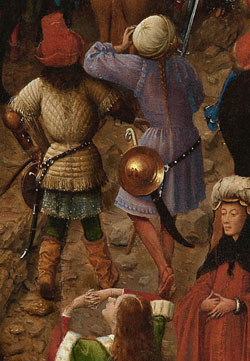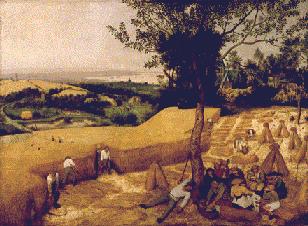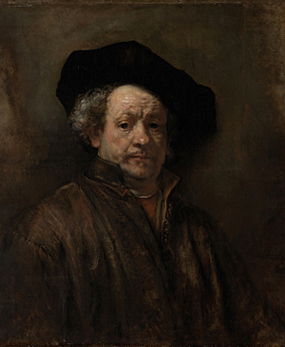Reaching for the Skylight
John Haberin New York City
The Skylight Project at the Met
I had forgotten so much in just two years. Just for starters, I had forgotten the glorious yellow in Harvesters, by Pieter Bruegel the Elder at the Met.
Or had I? The Museum had closed its galleries for European painting for the Skylight Project, replacing the glass in each and every one. Half reopened in December 2020, and my experience of them began with just those fields of wheat. How much has the illumination improved, how much was I merely primed to look for light and color, and how much of the credit goes to Bruegel alone? Even now that the rest has reopened, I cannot say for sure, but the collection looks great all the same. It also looks at once classic, tendentious, illuminating, and confusing. 
If you are expecting natural light flooding the galleries, you can only be disappointed to see thousands of bulbs behind the thousands of new panes of glass. But then, the Met is nothing if not controlling, and they seem just right for European painting. They bring out the depth and warmth of Bruegel's yellow. They also bring out darker woods by Peter Paul Rubens in the same room and some startling curatorial choices. So why look up? Look around you—and not just for the mutual flattery of art and light.
Test your memory
The 2020 partial reopening alone could test anyone's memory. Where else in the Americas can one see side by side so many portraits by Diego Velázquez, the supreme portrait painter of Spain—and, apart from Rembrandt, the Baroque? Where else would one enter through an entire room for Tiepolo's Venice? Not that Tiepolo is all that deep, but his crowded skies are deep enough. Still, museum politics was complicated from the start. The Met was always an attempt to put this country on the world stage, by any means necessary.
One could see that in 2008 in a show of the Philippe de Montebello years, dedicated to its then departing director—and one could see it again in fall 2020 "Making the Met." Regardless, it would take a powerful memory indeed to say just what the project's first phase leaves out. Where are twenty-four other rooms, I kept wondering, and what will they contain? I would just have to wait well into 2023 to see. Meanwhile Dutch paintings from the age of Rembrandt remained on temporary display in the Robert Lehman wing, along with Francisco de Goya, to help convince you that nothing is missing. As ever, the European painting galleries run only through around 1800, and the prelude to Impressionism picks up elsewhere, in a wing to the south. Like many a good story, this one begins in medias res (or in the midst of things). After a second gallery for Baroque showpieces, one can make a right for a warren of rooms. Most, though, will wish to start with either of four rooms apiece to the left. In the past, one held the Northern Renaissance and the other Italy, like museum wings to themselves. Now the first had me looking right at Pieter Bruegel from around 1565. Then came a room for "the German moment," meaning the Protestant Reformation, with work by a close admirer of Martin Luther, Albrecht Dürer, to name just one.
These rooms already mix northern and Italian art. And just when you thought you had pinned down their history, they doubled back to the "legacy" of Giotto in the 1300s. A Madonna and Child by Duccio looks less every year like an "Italian primitive" and a costly, controversial acquisition—and instead more regal, more revolutionary, and more tender. Giotto himself gives Joseph, a mere human, due dignity along with a child god, a god's mother, kings, shepherds, and angels. This is the Met I want to remember. Yet it has also changed, and you may well wonder just what is going on.
An expanded MoMA has rehung its collection regularly, as its "fall reveal," while the Morgan Library has added a garden, but the Met goes further. Nations, chronology, and artists no longer serve as organizing principles. It instead has themes, including genres like still life, landscape, and portraiture. Even then, a room for history painting, with Nicolas Poussin and Peter Paul Rubens, runs more to the Bible and myth than to war and peace. To justify its mix of the north and Italy, the Met speaks of a growing interchange between them. And that did happen, spreading oil painting and political influence, but it quickly loses track of where, when, and how.
Other themes, both in 2020 and now, turn to fashionable concerns for context and diversity. Labels point to the slave trade in Europe starting in the Renaissance and to colonialism in Africa. Still, that text introduces a glistening painting by Filippino Lippi without a servant in sight—and the sole black male, from Quentin Massys, appears among the wise men at the birth of Jesus because, tradition insists, it attracted the entire earth. A banker and his son, in a Renaissance portrait by Domenico Ghirlandaio, appear under the heading of new collectors with new money. Never mind that Ghirlandaio stood for a homespun realism that would look at home on Instagram today. And then one walks right into the ostentatious frivolity and wealth of eighteenth-century France.
Fields of wheat
The Met's big reveal is still a revelation. At least some of its themes ring true. That big opening room in 2020 for showpieces bears the title "Naturalism and Theatricality," and how better to describe the early Baroque of Caravaggio? His Denial of Saint Peter depends on the paradox,  and it hangs beside The Supper at Emmaus by Velázquez—twin challenges to humanity to recognize a god. Musical instruments lie behind glass doors in the Met's American wing, past a social encounter by Georges de La Tour. One can only hope that their placement is intentional.
and it hangs beside The Supper at Emmaus by Velázquez—twin challenges to humanity to recognize a god. Musical instruments lie behind glass doors in the Met's American wing, past a social encounter by Georges de La Tour. One can only hope that their placement is intentional.
Less than successful themes can pay off, too. For Anthony van Dyck and Rubens, an oil sketch can approach precision, while a finished painting can retain the brushwork and spontaneity of a sketch. The theme of "Most Perfect Style" accommodates High Renaissance artists like Andrea del Sarto and Correggio, known more for mastery than penetration. Yet their mastery makes them at home with Titian and Veronese. Colonialism and capitalism really did change the face of Europe at that. Even trendiness can have a basis in scholarship and fact.
Diversity is just as trendy and just as pertinent. It may not shake up the cast of artists and subjects all that much, but Neoclassicism reserves half a wall for women. A self-portrait with eager students, by Adélaïde Labille-Guiard, allows her pride of place as a painter, a teacher, and a mentor to young women. A girl holding a mirror, by Elisabeth Vigée Le Brun, makes her nurturer and illusionist as well. The girl is shyly intent on her image in the mirror, which then plays directly to you. A self-portrait by Rubens with his much younger wife and their little boy has much the same play on love as self-fulfillment and interdependence.
Whatever the theme, one can count on the work. The Met has long milked its authority. It has put forth attributions to Jan van Eyck and his student, Petrus Christus, that I still cannot accept. And yet they are among my favorite works (so do check the links here throughout for past reviews). How wonderful again to see van Eyck's vision of the Crucifixion and Last Judgment, each an entire world. How wonderful, too, to see Saint Jerome accepting the Eucharist for Sandro Botticelli, in the taut religious fervor of his late work.
Themes aside, too, the skylights are literally an illumination, with a mix of natural and artificial light behind clouded glass. It had me alert to daylight for Bruegel, but also to hellfire for a follower of Hieronymus Bosch and the twinkling stars behind a Crucifix for Hendrick ter Brugghen not far away. You may not think of Bruegel as a colorist, given his earthier palette than the costly ground pigments of contemporaries. But then for him, as with his Wedding Dance, the earthiest of subjects are central to the greater rhythm of life. Here the breadth of the landscape stands for that sweep. It extends along a diagonal from peasants, male and female, drunk asleep or slurping down the rewards of their labor.
The land suddenly descends, past others still at work, to where one can catch still others in the distance at play. One can almost overlook the glow of a church closer to the foreground, behind the less dignified supper at right. Anchoring them all is a single tree—and the yellow fields of wheat. Women are bundling the harvest rather like tepees, and one bent to her task unconsciously adopts their shape. What lies far off on the horizon, where rural and urban life together dissolve in a vision close to white? The cycle may simply begin again, and it will not end with the next grand museum renovation.
Europe's theme park
As the leap ahead from Bruegel's Mannerism to Rubens in the Baroque suggests, the rehanging in 2023 is more provocative than ever. The provocations have changed, to be sure, but not by much. The Met has had three years to rethink its choices, but it is telling the same story. Its account of the Renaissance now begins with "faces," from both Italy and Northern Europe. One could almost forget how different the two were in style, purpose, and media. One might not so easily forget the double portrait by Filippo Lippi in Italy, with the solidity of his teacher, Masaccio, and a meeting of the sexes at a window ever so close to home.
More provocative still are the themes, again one to a room. As present times require, they describe art as instrumental. Not just one Madonna but two by Giovanni Bellini, early and late in his shift to painting in oil, fall under "Trade and Transformation in Venice—and so does the pain in a Lamentation by Vittore Carpaccio. "Faith and Love in Venice" has room for a more otherworldly love, in the eerie light of Savoldo. Even with Peter Paul Rubens, in "Flesh and the Spirit," I leapt right to the spirit, for Saint Francis adoring a Holy Family so perfect that it excludes Joseph. I would have admired an independent Dutch nation in "The Patriotic Landscape," but I was too busy with the variety of skies and worldly pursuits.
We are talking race, class, and power in a proper postmodern way. Does it matter that the prize portrait in "Portraits and Power" is not of wealth and power, but of Juan de Pareja, the slave whom Diego Velázquez set free to become a painter? Did Giambattista Tiepolo include blacks in his busy heavens? It is a game of Where's Waldo to find out. It might be best to take all the rooms as a game, asking you to guess the theme. Please do not criticize yourself if you fail.
 One last provocation is easier to ignore. Museums these days make a point of modern and contemporary art, like the Met itself with its new hanging for Korean art. Almost halfway through, I thought that these galleries had escaped that fate, but no. Pablo Picasso in his Blue Period turns up with El Greco, Salvador Dalí with Spain, and Max Beckmann with Francis Bacon on the way in. None look the better for it. A "focus gallery" for artists in their studio has room for Kerry James Marshall, Elaine de Kooning, and more.
One last provocation is easier to ignore. Museums these days make a point of modern and contemporary art, like the Met itself with its new hanging for Korean art. Almost halfway through, I thought that these galleries had escaped that fate, but no. Pablo Picasso in his Blue Period turns up with El Greco, Salvador Dalí with Spain, and Max Beckmann with Francis Bacon on the way in. None look the better for it. A "focus gallery" for artists in their studio has room for Kerry James Marshall, Elaine de Kooning, and more.
Still, all is not lost, not with a collection like this. The Met has reined in the worst as well. It now as clearer divisions by time and place than in 2020. Just as much, the drawbacks can become advantages. Taking away separate wings for the Renaissance translates into a smooth arc from the origins of landscape and illumination to the real thing. The Baroque becomes not just a rebellion, but also an evolution. And the themes challenge you to retrace that evolution.
The return of European painting is not just a provocation. It is also a recovery and a relief. One may never feel close enough to Rembrandt in a room the size of a football field, but a full wall for Jan Vermeer is something else again. One can also appreciate the span of European art. It has room now for the Americas, in the eighteenth century, in a room that (surprise!) opens onto the Met's American wing. A room later, both wings contain musical instruments, but each has a music of its own.

The first phase of the Skylight Project concluded in December 2020 at The Metropolitan Museum of Art, the second in November 2023, after closing the galleries for an additional eight months.




